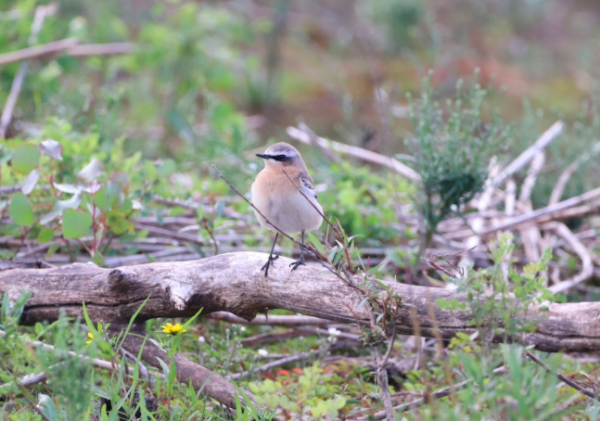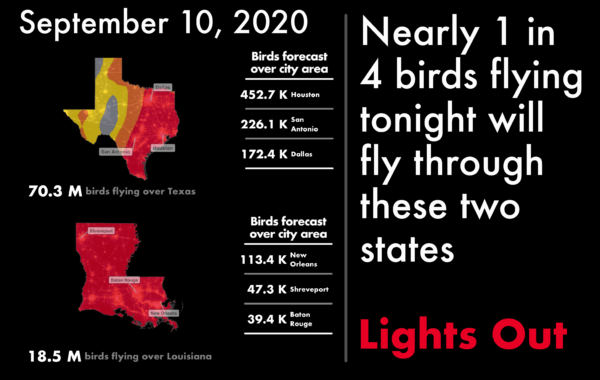At this point you have heard the stories for the west about bird mortality, but perhaps you have not heard the stories about species on the move out of the mountains. BirdCast will feature evolving stories about eruptions from higher elevations, and this week we highlight Mountain Chickadee. Read more...
Hurricane Teddy is arriving soon in Atlantic Canada. A significant diversity of tropical seabirds may arrive with it in Nova Scotia, Newfoundland, and possibly even Greenland. Read more...
Beta is currently a tropical storm, deteriorating to a tropical depression in the next 36-48 hours. Storm birds will be apparent on the Upper Texas coast from Monday through Wednesday, whereas areas further inland into southwestern and central Louisiana may experience some impacts by Thursday. Read more...
Strong northeasterly winds in the western North Atlantic may hearken the arrival of small (very small) numbers of Northern Wheatears in eastern North America. Several have been reported in the last days, will more arrive soon? Read more...
Enormous, and growing, numbers of dead birds discovered in the southern Rockies over the past few weeks have alarmed scientists, conservationists, and advocates alike. The massive mortality events may be a result of intense fires in the western US and the smoke that they have produced. Read more...
Yes, you read the title right— WHITE-breasted Nuthatches! Long overlooked as a humble resident of forests and feeders across North America, the *other* migrating nuthatch is finally getting deserved recognition for its irruptive travels. Read more...
We estimate that more than half a billion birds will take flight tonight from the contiguous US, spanning the central portion of the country from Canada to Mexico. Read more...
The active week for tropical systems in the Atlantic Ocean Basin continues, with Hurricane Sally making landfall on the Gulf of Mexico coast. A suite of species like Sooty Tern, Bridled Tern, Magnificent Frigatebird, and Brown Noddy is possible at the immediate coast and well inland. Watch live tracking of bird observations after Sally's landfall. Read more...
The BirdCast model is predicting high intensity migration for the night of 14 September 2020. We estimate that 405 million birds will take flight tonight across the lower 48, including 50 million birds in the northeast alone. This will likely represent one of the largest migration nights of the year in this region. Read more...
High intensity migration and evolving tropical systems are on deck for this week. We estimate movements 400-500 million birds on each of the coming nights over the continental US. Plus, a very active Atlantic Ocean Basin has a number of tropical systems of the move, entraining and displacing a diversity of birds in the Gulf of Mexico region and Bermuda. Read more...
The BirdCast forecast model is predicting high intensity migration this evening, and we estimate this migration will comprise more than 400 million birds. The highest intensity movements will occur in Texas and portions of the southern Appalachians and lower Mississippi River valley. Read more...
A major disturbance bringing large temperature drops and snow will move through the northern and central Rockies in the next 48 hours. Local movements of residents and shorter distance migrants are likely as a result, as are concentrations of birds along the frontal boundaries of the cold air mass. Read more...
More than 200 million migrants will be aloft this evening over the US. These massive movements present some unique opportunities to experience bird migration and act to protect birds by turning off lights at night! Read more...
Nana is approaching the coast of Central America, bringing with it the potential for tropical seabirds and downed overland migrants. Read more...
Watch for Wilson's Warbler, a species on the move right now (and perpetually given this species' energetic personality), whether you are birding east or west! Read more...
You've recently watched a small flock of songbirds fly over while watching an autumn morning's migration unfold, perhaps hearing a sharp "tick, tick... tick, tick" even before seeing the birds. Congratulations, you've seen a Purple Finch, this week's species on the move. Read more...
Laura is or will soon intensify to a Major Hurricane with unsurvivable storm surge and extremely dangerous conditions. Current forecasts predict landfall near the Texas-Louisiana border. Avian impacts from Laura's landfall north to Arkansas and east through western Tennessee are likely on Thursday and Friday. Read more...
This week the Gulf Coast of the US will experience landfall of two tropical systems, Laura and Marco. This dangerous twin bill will come with flooding, storm surge, heavy rains, and wind in many areas of the western Gulf of Mexico and lower Mississippi River valley. BirdCast is tracking the arrival of the two storms, and you can monitor with us on two maps tracking bird observations as they occur with landfall. Read more...
Team BirdCast like many other groups is watching the progress of three tropical systems that may make landfall in the US next week. Stay tuned for updates in the coming days! Read more...
Could recent August observations of Red-breasted Nuthatch in coastal New York represent the beginning of another strong southbound flight of the species this autumn and winter? Read on to consider patterns, correlations, and ways you can help us understand these movements by submitting your observations! Read more...
























